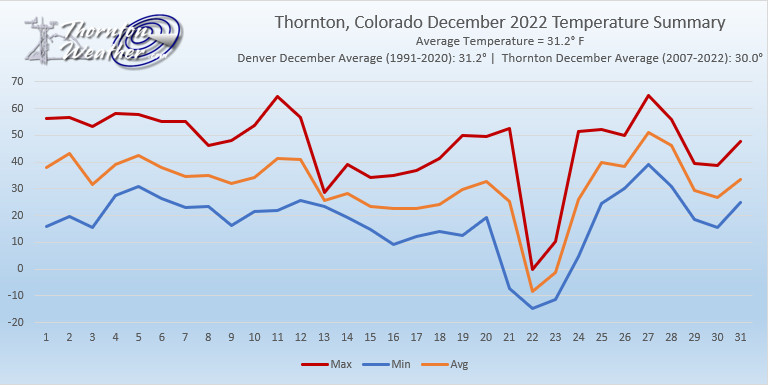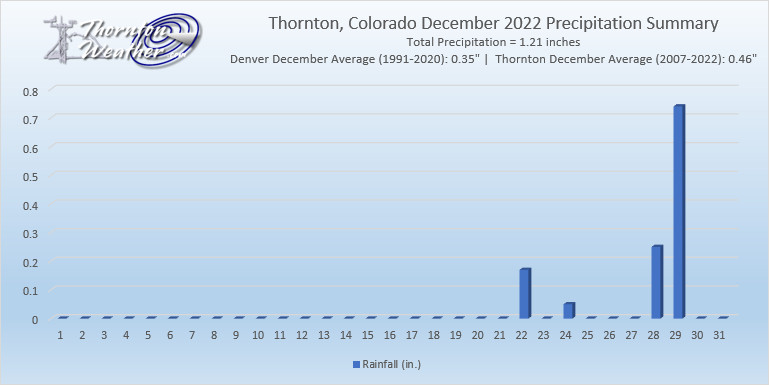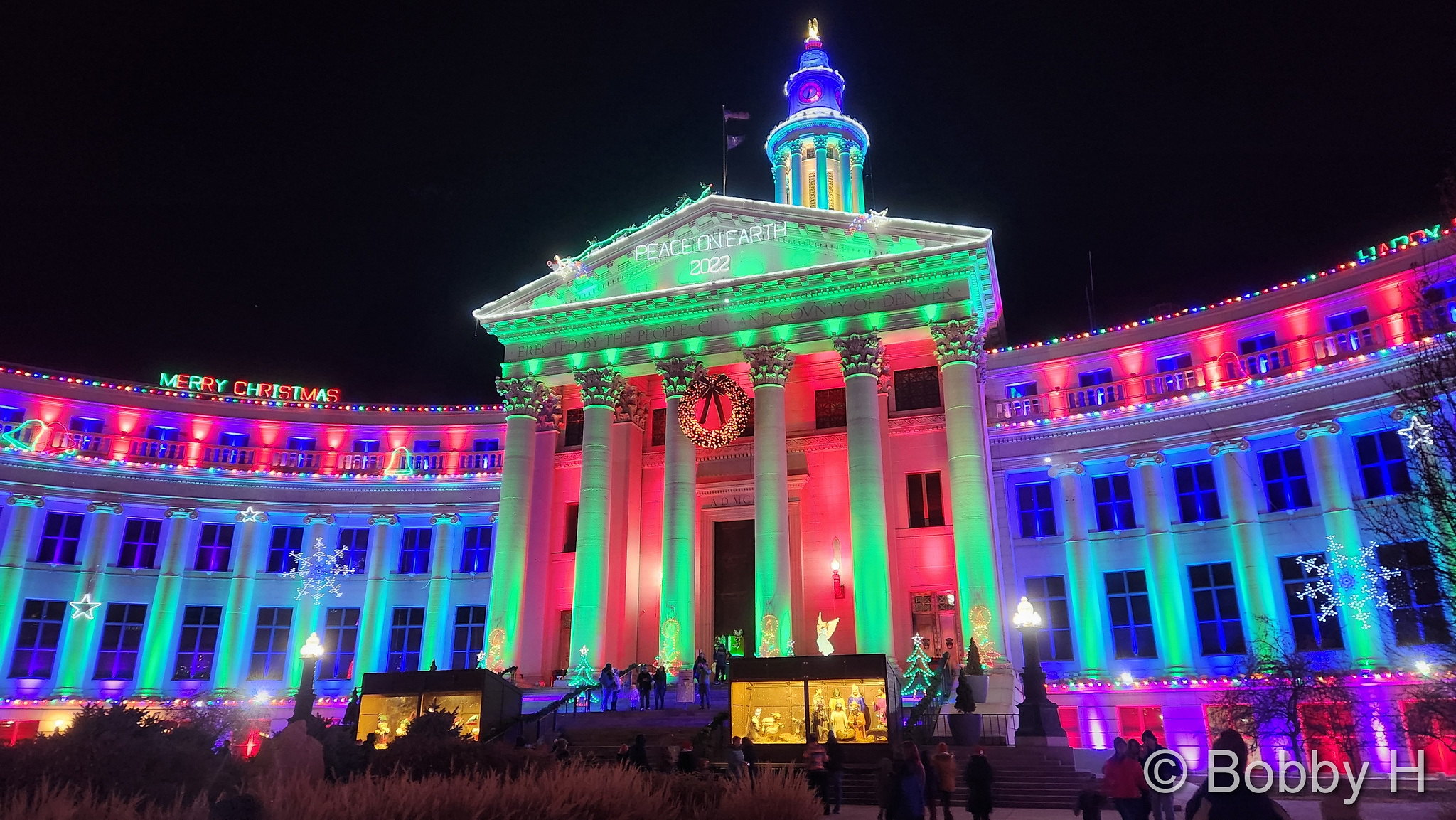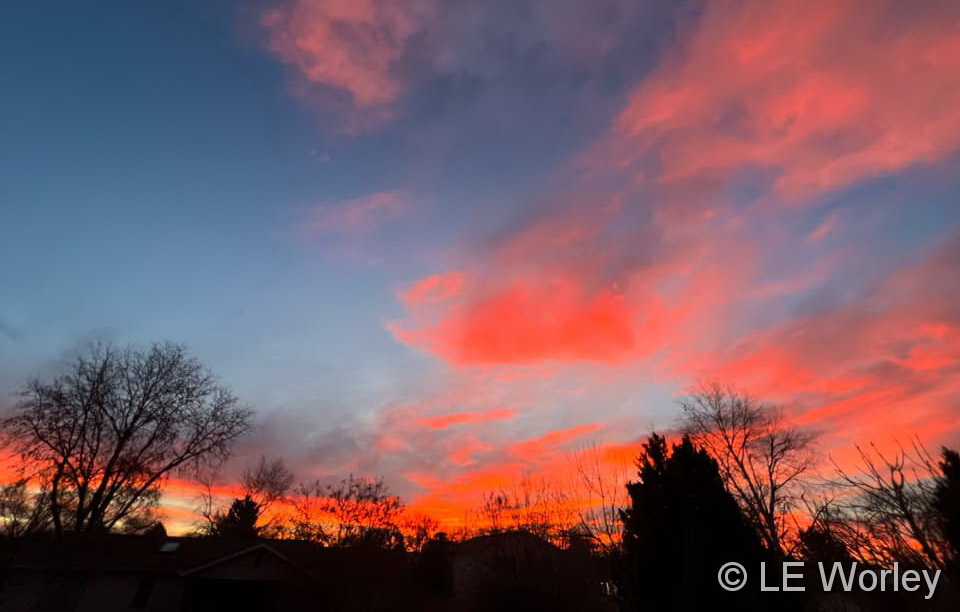
Cold, snow and wind are the dominant conditions we see in our look back at this week in Denver weather history. All three are common this time of year and extremes with those conditions seem to be unusually common as well.
Among the highlights are numerous high wind events that not only caused damage but also injury to unprepared residents. Significant snowfall also appears many times including a storm in 1983 that shut down the city for the Thanksgiving weekend and left snow on the ground for 63 days.
From the National Weather Service:
25-26
In 1887…snowfall totaled 2.9 inches in the city. This was the only measurable snow of the month. Northeast winds were sustained to 18 mph on the 26th when the temperature dipped to 12 degrees below zero.
In 1959…a sharp cold front produced a northwest wind gust to 51 mph…followed by snow and falling temperatures from a high of 60 degrees to a low of 23 degrees at midnight on the 25th. Snowfall totaled 4.4 inches at Stapleton Airport before ending early on the 26th.
In 1972…winds gusted to 104 mph at the Rocky Flats plant south of Boulder. Gusts to 70 mph were recorded at the National Bureau of Standards in Boulder…while in downtown Boulder winds peaked to 68 mph. Some damage was reported. Northwest winds gusted to 47 mph at Stapleton International Airport on the 26th.
In 1984…blowing snow closed I-70 east of Denver…stranding over a thousand travelers in Limon. Denver received only 2.3 inches of snowfall. North winds gusted to 31 mph at Stapleton International Airport.
In 1999…strong Chinook winds redeveloped overnight in and near the foothills. Peak wind gusts included 72 mph atop Blue Mountain near Wondervu and at the National Center for Atmospheric Research mesa lab above Boulder.
25-27
In 1978…heavy snowfall of 6.0 inches was measured at Stapleton International Airport where north winds gusted to 20 mph. Most of the snow…4.8 inches…fell on the 25th. The greatest amount of snow measured on the ground was 5 inches due to settling and melting.
25-28
In 1952…the average coldest 4-day period in November in the previous 81 years of record occurred. Maximum temperatures of 19…15…21…and 25 degrees were recorded. Minimum temperatures were below zero each day with readings of 7 below…6 below…5 below…and 6 below.
25-29
In 1985…dense fog with visibilities as low as 1/8 mile occurred on five consecutive days at Stapleton International Airport. The fog was at times accompanied by light snow… Light freezing drizzle…or ice crystals. Fog occurred all day on both the 26th and 29th.
26
In 1873…west winds increased to a violent gale at 3:00 am and reached a maximum sustained velocity of 56 mph at 3:15 am. The winds continued with a velocity of not less than 40 mph until 6:00 am. Winds continued brisk for the remainder of the day. The strong winds caused damage to houses and buildings in the city. Temperatures were in the 50’s through early afternoon with a recorded high of 59 degrees. Winds also blew strongly in Boulder and caused 300 dollars in damage.
In 1911…post-frontal northeast winds were sustained to 43 mph with gusts as high as 52 mph. Snowfall was only 0.5 inch.
In 1965…post-frontal snowfall totaled 5.5 inches at Stapleton International Airport where strong west winds gusted to 39 mph during the afternoon.
In 1976…2 to 4 inches of snow with an arctic cold front produced near zero visibility at times in blowing snow… Causing multiple automobile accidents in metro Denver. Snowfall totaled 3.5 inches at Stapleton International Airport where north winds gusted to 39 mph. Temperatures hovered in the teens and lower 20’s most of the day dipping to 7 degrees by midnight.
In 1977 a strong wind storm raked metro Denver. High winds blew windows from office towers in Denver and Boulder. Thirteen people were injured in Boulder due to flying debris. Wind gusts to 119 mph were clocked on Davidson Mesa southeast of Boulder…with 109 mph in downtown Boulder. Six airplanes were damaged at Jefferson County Airport near Broomfield. Winds to 90 mph were reported in Lakewood. Glass was blown out of several vehicles in Wheat Ridge…and roofs were blown off 4 houses in Arvada. Several houses under construction collapsed across metro Denver. Winds to 75 mph were reported at the Denver Federal Center with 90 mph at Rocky Flats. West winds gusted to 51 mph at Stapleton International Airport. Total insured damage from the wind storm was 2.2 million dollars.
In 1987…a thanksgiving snowstorm brought 5 inches of snow to metro Denver and 6 inches to the foothills. At Stapleton International Airport…snowfall totaled 5.0 inches…north winds gusted to 22 mph…and temperatures hovered in the upper 20’s most of the day.
In 1991…strong winds were recorded in and near the eastern foothills. Winds at Rollinsville were clocked to 70 mph with 45 mph recorded in Boulder and 51 mph at the U.S. Atomic Energy Commission Rocky Flats plant. West winds gusted to only 28 mph at Stapleton International Airport.
26-27
In 1876…heavy snowfall totaled 9.0 inches over the city from 5:00 pm on the 26th through 5:00 p.m. on the 27th. Precipitation was 0.30 inch on the 25th and 0.60 inch on the 27th.
In 1919…an incursion of cold arctic air produced snowfall of 4.6 inches over downtown Denver. Temperatures dipped to 5 degrees below zero on the evening of the 26th and recovered to a high of only 1 degree below zero on the 27th…the all-time record low maximum for the month of November and the record for the date. Northwest winds were sustained to 25 mph with gusts to 26 mph on the 26th.
In 1923…snowfall of 2.0 inches was the only snow of the month. North winds were sustained to 22 mph on the 26th.
In 1972…heavy snowfall totaled 7.5 inches at Stapleton International Airport where north winds gusted to only 18 mph on the 27th.
In 1983…a Thanksgiving blizzard dumped 21.5 inches of snowfall in 37 hours with a maximum of 18 inches on the ground at Stapleton International Airport. The storm produced howling winds…which paralyzed Thanksgiving weekend transportation across all of eastern Colorado. On the 27th…Stapleton International Airport closed… Opening 24 hours later. Interstate highways were closed in all directions…but west…from Denver. At Stapleton International Airport…north winds gusted to 36 mph on the 26th and to 29 mph on the 27th. However…most wind speeds across metro Denver were 15 to 30 mph. Temperatures hovered in the teens and lower 20’s. Many stores and businesses closed. Several high school football games were postponed. Across metro Denver…snow depth varied from 15 inches in Commerce City to 28 inches near Chatfield Reservoir. Snow removal in Denver was estimated at 1.5 million dollars. Following the storm… An inch or more of snow remained on the ground for 63 consecutive days through January 27…1984. This is the longest period of continuous snow cover ever recorded in Denver.
In 1990…an early winter storm deposited 2 to 8 inches of wet snow across metro Denver. Snowfall totaled 3.4 inches at Stapleton International Airport where northeast winds gusted to 30 mph on the 26th.
In 1993…strong winds swept off the foothills across metro Denver. Sustained winds of 30 to 50 mph were common across the area. Wind gusts to 67 mph were recorded atop Squaw Mountain near Idaho Springs. West winds gusted to 36 mph at Stapleton International Airport on the 26th. The strong winds produced some blowing snow…reducing the visibility to less than one mile at times.
In 1995…snowfall totaled 3.7 inches at the former Stapleton International Airport site. The foothills west of Denver received 4 to 7 inches of snow. North-northeast winds gusted to 34 mph at Denver International Airport on the 26th.
27
In 1965…strong winds buffeted Boulder…causing 11 thousand dollars in damage. Wind gusts to 75 mph were recorded downtown. West winds gusted to 38 mph at Stapleton International Airport.
In 1994…winds gusted to 87 mph atop Squaw Mountain…5 miles south of Idaho Springs…and to 84 mph on Fritz Peak near Rollinsville in the foothills southwest of Boulder. Northwest winds gusted to 40 mph at Stapleton International Airport.
In 2017…The maximum temperature for Denver reached 81 degrees which was 34 degrees above the normal high of 47 degrees. This difference between the actual high and the normal high was the second largest ever recorded for Denver. The only larger difference occurred on Dec 5…1939 when Denver was 35 degrees above normal. It also established a new record for the latest 80 degree day for the calendar year in Denver… breaking the previous date by 11 days.
28
In 1884…a windstorm during the afternoon produced northwest sustained winds to 46 mph. Two wooden slats were blown out of the weather instrument shelter…and nearly all of the slats on the north and west sides were loosened.
In 1898…northwest winds were sustained to 50 mph with gusts as high as 80 mph.
In 1902…northwest winds were sustained to 40 mph with gusts to 48 mph. The strong apparent Bora winds warmed the temperature to a high of only 40 degrees.
In 1904…northwest winds sustained to 44 mph with gusts to 58 mph warmed the temperature to a high of 58 degrees.
In 1927…strong west winds occurred in Boulder…causing widespread minor damage. A wind gust to 65 mph was recorded at Valmont east of Boulder. The west winds possibly produced a cyclonic twist.
In 1928…heavy snowfall totaled 7.0 inches over downtown Denver.
In 1957…a vigorous cold front produced north-northeast wind gusts to 54 mph at Stapleton Airport. Light snow following the front totaled only 0.2 inch.
In 1970…strong Chinook winds reached 77 mph in downtown Boulder.
In 1978…wind gusts 60 to 90 mph were reported in and near the foothills.
In 1984…high winds of 60 to 80 mph occurred along the Front Range eastern foothills.
In Boulder…the high winds blew the roof off a service station. Several trees were felled… Damaging some cars. An elderly woman was injured when she was knocked down by a wind gust and blown 20 feet into some bushes. Northwest winds gusted to 36 mph at Stapleton International Airport.
In 1994…winds gusted to 72 mph in Boulder. No damage was reported. Northwest winds gusted to 35 mph at Stapleton International Airport.
28-29
In 1908…heavy snowfall overnight and for most of the day on the 29th totaled 12.5 inches. Precipitation was 1.09 inches. Northwest winds were sustained to 26 mph on the 29th.
In 1928…a major storm dumped 15.5 inches of snowfall on downtown Denver. North winds were sustained to 18 mph with gusts to 19 mph on the 28th.
In 1992…an upper level storm system moved across metro Denver…but left only a dusting of snow. Snowfall totaled only 1.6 inches at Stapleton International Airport where north winds gusted to 25 mph. Other snow amounts included: 8 inches at Conifer…6 inches at Lake Eldora…3 inches at Rollinsville and in southeast Denver.
In 1997…a storm system tracking across northern New Mexico produced strong north to northeast upslope flow against the eastern slopes of the Front Range and Palmer Ridge. Snowfall totals in Jefferson County included: 14 inches near Deckers; 12 inches at Castle Rock and Sedalia; 10 inches near Conifer…11 miles southwest of Morrison…and at Buffalo Creek. Elsewhere…snow accumulations were less. Snowfall totaled only 0.7 inch at the site of the former Stapleton International Airport on the 27th and 28th.
In 2004…heavy snow fell in the foothills and across metro Denver. In the foothills…snowfall totals included: 13 inches at Roxborough State Park and Eldorado Springs… 11.5 inches near Conifer…11.0 inches near Nederland…and 10 inches near Indian Hills. Across metro Denver snowfall totaled 14 inches near Sedalia…9 inches near Louisville… 8 inches at Ralston Reservoir…and 5.1 inches in the Stapleton area of Denver. Northeast winds gusted to 28 mph at Denver International Airport on the 28th.
In 2006…a slow moving storm system brought heavy snow to the mountains and to the eastern foothills where snowfall ranged from 8 to 18 inches. Some of the more impressive snow totals included: 18 inches at Genesee…17.5 inches near Boulder…17 inches at Aspen Springs…16.5 inches 10 miles northwest of Golden…15 inches at Eldorado Springs… 14.5 inches in Idaho Springs and near Jamestown…12 inches in grant and near Indian Hills…11.5 inches near Blackhawk… 11 inches at Gross Reservoir and Eldora…and 10.5 inches in Conifer. Across metro Denver…storm total snowfall generally ranged from 5 to 9 inches with the heaviest amounts near the foothills in Boulder and Jefferson counties. The most impressive totals included: 15.5 inches at Ken Caryl…12 inches in Boulder…7.5 inches near Morrison…and 7 inches near both Chatfield and Ralston reservoirs. Snowfall totaled only 4.2 inches in the Denver Stapleton area. Northeast winds gusted to 31 mph at Denver International Airport on the 28th.
28-30
In 1991…a winter storm dumped heavy snow in the foothills and near the palmer divide with 10 inches recorded at Conifer and Golden Gate Canyon…12 inches in Morrison… 6 inches at Castle Rock and Parker. Only 3.4 inches of snow fell at Stapleton International Airport where north winds gusting to 35 mph on the 29th…produced some blowing snow. Some light freezing drizzle also fell on the 28th and 29th.
29
In 1877…the all-time lowest recorded minimum temperature in the month of November…18 degrees below zero…occurred. The high temperature for the day was 16 degrees.
In 1899…northwest winds were sustained to 51 mph with gusts as high as 60 mph. The Chinook winds warmed the temperature to a maximum of 74 degrees…a record high for the date and the warmest of the month that year. The minimum temperature was only 39 degrees.
In 1927…post-frontal rain changed to snow and totaled 5.8 inches over downtown Denver. Northeast winds were sustained to 22 mph.
In 1977…85 mph winds were reported at Wondervu in the foothills southwest of Boulder. Northwest winds gusted to 39 mph at Stapleton International Airport.
In 1980 strong Chinook winds reached 85 mph in Boulder… Blowing traffic signals and street lights down. Some windows were shattered by the wind. West winds gusted to 37 mph at Stapleton International Airport.
In 1994…high winds blew across the Front Range eastern foothills. Wind gusts to 92 mph occurred atop Squaw Mountain…5 miles south of Idaho Springs…and to 82 mph on Fritz Peak near Rollinsville in the foothills southwest of Boulder. A wind gust to 75 mph was recorded at Jefferson County Airport near Broomfield. Northwest winds gusted to only 35 mph at Stapleton International Airport. No damage was reported.
29-30 in 2008…a storm system produced locally heavy bands of snow across Douglas…Elbert and eastern Jefferson counties. Northerly winds gusting to 50 mph caused snow drifts to pile up to 2 feet in depth. Storm totals included: 12 inches just southwest of Kassler…11.5 inches…6.5 miles southwest of Castle Rock; 11 inches…8.4 miles southeast of Aurora and 9 miles west of Littleton; 10 inches at Louviers… 8 inches…2 miles west-southwest of Highlands Ranch and 5 miles south-southeast of Sedalia…and 7.5 inches…14 miles west-southwest of Agate and at Castle Pines. At Denver International Airport…2 inches of snow was observed. North winds gusted to 46 mph on the 30th.
30
In 1899…west winds were sustained to 45 mph with gusts as high as 48 mph.
In 1903…west winds sustained to 44 mph with gusts to 54 mph warmed the temperature to a high of 57 degrees.
In 1981…strong winds blasted the foothills. In Wondervu… Winds were clocked to 81 mph with many other locations in the foothills reporting over 60 mph. Northwest winds gusted to 28 mph at Stapleton International Airport.
In 1986…the worst snow storm of the season dumped from 5.0 inches of snow at Stapleton International Airport to 14 inches over the higher southwestern suburbs. On the Sunday after Thanksgiving…one of the busiest travel days of the year at Stapleton International Airport…two of the four runways were closed and flights were delayed up to four hours. Near-blizzard conditions prevailed on the plains east of Denver…closing both I-70 and I-76 for a time. North wind gusts to 36 mph were recorded at Stapleton International Airport.
In 2000…strong winds raked metro Denver. In Thornton…a construction worker was critically injured when the scaffolding on which he was standing collapsed…throwing him 25 feet to the ground. West winds gusted to 54 mph at Denver International Airport.
30-1
In 1929…heavy snow blanketed the city. Snowfall totaled 9.8 inches downtown. North winds were sustained to 32 mph with gusts to 37 mph on the 30th.
In 1970…high winds blasted Boulder and the eastern plains. In Boulder…a wind gust to 112 mph was recorded at the National Center for Atmospheric Research with a gust to 96 mph at the National Bureau of Standards. In downtown Boulder…wind gusts reached 76 mph. At Stapleton International Airport…winds gusted to 47 mph. The high winds caused widespread light to moderate property damage across most of metro Denver. Roofs…signs…trees…power lines…and other property were damaged. Blowing dust reduced visibility to near zero over most of eastern Colorado. Several mobile homes…campers…and semi-trailers were blown off the highways north of Denver.
In 1985…an intrusion of cold arctic air into metro Denver resulted in setting 3 temperature records. The temperature climbed to only 17 degrees on the 30th…setting a record low maximum for the date. On the 1st…the temperature plunged to 6 degrees below zero…setting a record low for the date… And warmed to only 7 degrees…setting a record low maximum for the date.
30-2
In 1975…very strong Chinook winds up to 100 mph caused damage to homes…aircraft…aircraft hangars…mobile homes… Cars…and power lines along the eastern foothills. Strong northwest winds gusted to 39 mph at Stapleton International Airport on both the 30th and the 1st.
1
In 1899…northwest Chinook winds were sustained to 47 mph with gusts to 60 mph. The strong Chinook winds warmed the temperature to a high of 61 degrees…the warmest of the month. The low temperature dipped to only 39 degrees.
In 1972…strong Chinook winds gusted in excess of 65 mph in Boulder. There were no reports of damage. Northwest winds gusted to 38 mph at Stapleton International Airport.
In 1992…strong winds continued through the early morning hours. Wind gusts to over 70 mph were measured at reporting sites in the foothills west of Denver. In west Boulder…wind gusts reached 71 mph with 77 mph measured at Rollinsville. At Stapleton International Airport northwest winds gusted to 39 mph. The walker ranch…an historic site west of Boulder…burned down overnight during the high wind event. Although the winds did not cause the fire…they did hamper efforts to extinguish the blaze.
In 1996…high winds howled in and near the Front Range foothills. Winds gusted to 105 mph at Wondervu southwest of Boulder and to 70 mph at Jefferson County Airport near Broomfield. West winds gusted to only 24 mph at Denver International Airport.
1-2
In 1933…apparent post-frontal heavy snowfall totaled 8.0 inches across downtown Denver. North winds were sustained to 17 mph with an extreme velocity to 18 mph on the 1st.
In 1981 strong winds gusted to over 70 mph along the foothills. A peak gust to 100 mph was recorded at Wondervu. A gust to 94 mph was recorded just west of Boulder. Roofs on houses were damaged in the Evergreen area…and some mobile homes also were damaged. At Stapleton International Airport…northwest winds gusted 44 mph on the 1st and 37 mph on the 2nd.
1-5
In 1913…the 1st marked the start of the heaviest 5-day total snowfall in the city’s history. During this period snowfall totaled 45.7 inches. Starting on the 1st…snow fell intermittently for 3 days and accumulated a little over 8 inches. On the 4th and 5th…an additional 37.4 inches of snow fell. At Georgetown in the foothills west of Denver even more snow fell…86 inches over the 5 days with the most…63 inches…on the 4th. In Colorado…snowfall was heavy along the eastern slopes of the mountains from the Palmer Divide north. High winds during the storm caused heavy drifting…which blocked all transportation. Snow cover of an inch or more from the storm persisted for 60 consecutive days from the 1st through January 29…1914. Additional snowfall in December and January prolonged the number of days. This is the third longest period of snow cover on record in the city.
2
In 1893…northwest winds were sustained to 42 mph with gusts to 46 mph. Snowfall was only 1.4 inches in the city.
In 1895…0.01 inch of melted snow from 0.7 inch of snowfall was the only measurable precipitation of the month in downtown Denver…ranking the month the 3rd driest December on record.
In 1899…post-frontal northeast winds sustained to 44 mph with gusts to 59 mph caused the temperature to plunge from a high of 55 degrees to a low of 15 degrees. Snowfall was only 1.0 inch.
In 1902…apparent post-frontal northwest winds were sustained to 45 mph with gusts to 53 mph. A trace of snow fell.
In 1905…only a trace of snow fell in downtown Denver. This was the only snow and precipitation for the month… Ranking the month the second driest and the second least snowiest December on record.
In 1921…snowfall was 5.5 inches in downtown Denver. Northwest winds were sustained to 24 mph with an extreme velocity of 25 mph.
In 1951…a vigorous pacific cold front produced a northwest wind gust to 51 mph at Stapleton Airport where brief blowing dust was observed.
In 1957…a strong pacific cold front produced northwest wind gusts to 54 mph at Stapleton Airport where the surface visibility was briefly reduced to 1 1/2 miles in blowing dust.
In 1977…high winds in Boulder lifted a warehouse from its foundation and ripped it apart. Wind gusts from 60 to 103 mph toppled and injured a man while walking. Winds were clocked to 104 mph at Nederland…100 mph at Morrison…and 62 mph at Rocky Flats. Northwest winds gusted to 41 mph at Stapleton International Airport.
In 1996…for the second day in a row high winds ripped the Front Range foothills. Winds gusted to 81 mph in Golden Gate Canyon. West-northwest winds gusted to 37 mph at Denver International Airport.
In 2013…high winds developed ahead of an approaching storm system. The strong winds downed several trees around Evergreen. Peak wind gusts included: 79 mph…4 miles west-southwest of Eldorado Springs; 78 mph…3 miles south of Evergreen; 75 mph and the NCAR Mesa Lab; and 69 mph in Longmont.
2-3
In 1955…snowfall totaled only 2.9 inches at Stapleton Airport. This was the only measurable snowfall of the month.
In 1973…post-frontal heavy snowfall totaled 7.6 inches at Stapleton International Airport where northeast winds gusting to 37 mph caused some blowing snow.
In 1990…strong downslope winds raked the eastern foothills and most of metro Denver. A wind gust to 87 mph was recorded at Rollinsville with wind gusts to 58 mph in Arvada and 55 mph in Lakewood. West winds gusted to 48 mph at Stapleton International Airport on the 2nd.
In 1997…heavy snow fell in the foothills. Conifer received 10 inches of new snow. Snowfall totaled only 2.4 inches at the site of the former Stapleton International Airport on the 1st…2nd…and 3rd. North winds gusted to 24 mph at Denver International Airport on the 2nd.
2-4
In 1909…post-frontal snowfall totaled 6.1 inches in downtown Denver. Most of the snow…5.9 inches…fell between 6:00 pm on the 2nd and 6:00 pm on the 3rd. North winds were sustained to 18 mph on both the 2nd and 3rd.
2-17
In 1939…more than 2 weeks of unseasonably warm weather made the month the 3rd warmest on record. Seven daily temperature records were set…including the all time record high temperature for the month of 79 degrees on the 5th. Daytime highs were balmy with 14 days in the 60’s and 70’s. Low temperatures dipped to freezing or below on only 5 days. The period was dry with only a trace of snow on the 12th.





